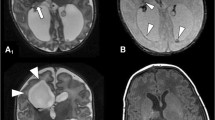Abstract
Purpose
The purpose of the study is to determine corticospinal organization using intraoperative neurophysiologic monitoring (IONM) during resective epilepsy surgery for patients with congenital hemiparesis and intractable epilepsy.
Methods
Ten patients, aged 3–17, with intractable epilepsy underwent resective surgery. Transcranial stimulation (TCS) was achieved using a pair of cork screws at Cz and C3/C4, respectively. A 1 × 4 stimulating electrode strip was placed on the presumed motor cortex of the affected hemisphere for direct cortical stimulation (DCS) after craniotomy. Multipulse TCS and DCS train stimulation was delivered, with simultaneous recordings from bilateral abductor pollicis brevis and abductor halluces, to determine the corticospinal projection pattern of the paretic limbs.
Results
The above mapping techniques revealed ipsilateral corticospinal projections from the contralesional hemisphere to target muscles in the paretic limbs in three patients, projections from both hemispheres to target muscles in three, and preserved crossed projections from the affected hemisphere in four. Nine patients were seizure free after surgery. Five had unchanged postoperative functional status, and three showed minimally improved use of the paretic hand. Two developed new motor deficits after surgery, which may have been due to a premotor syndrome in one patient, since it completely resolved within 2 weeks. The other experienced increased weakness of the paretic lower limb because a small part of the eloquent cortex was removed for better seizure control.
Conclusions
Using IONM to define the corticospinal projection pattern is a valuable technique that can potentially replace preoperative fMRI and transcranial magnetic stimulation in resective epilepsy surgery, particularly for younger patients.



Similar content being viewed by others
References
Oskoui M, Shevell MI (2005) Profile of pediatric hemiparesis. J Child Neurol 20:471–476
Gupta A, Carreno M, Wyllie E, Bingaman WE (2004) Hemispheric malformations of cortical development. Neurology 62(6 suppl 3):S20–S26
Caldarelli M, Tamburrini G, Rocco CD (2002) Congenital hemiparesis and seizures secondary to perinatal occlusion of the middle cerebral artery. Pediatr Neurosurg 37:220
Nelson KB, Lynch JK (2004) Stroke in newborn infants. Lancet Neurol 3:150–158
Carreno M, Kotagal P, Jimenez AP et al (2002) Intractable epilepsy in vascular congenital hemiparesis: clinical features and surgical options. Neurology 59:129–131
Edwards JC, Wyllie E, Ruggeri PM et al (2000) Seizure outcome after surgery for epilepsy due to malformation of cortical development. Neurlogy 55:1110–1114
Pascoal T, Paglioli E, Palmini A et al (2013) Immediate improvement of motor function after epilepsy surgery in congenital hemiparesis. Epilepsia 54:e109–e111
Hallbook T, Ruggieri P, Adina C et al (2010) Contralateral MRI abnormalities in candidates for hemispherectomy for refractory epilepsy. Epilepsia 51:556–563
Mehta AD, Klein G (2010) Clinical utility of functional magnetic resonance imaging for brain mapping in epilepsy surgery. Epilepsy Res 89:126–132
Juenger H, Kuhnke N, Braun C et al (2013) Two types of exercise-induced neuroplasticity in congenital hemiparesis: a transcranial magnetic stimulation, functional MRI and magnetoencephalography study. Develop Med Child Neurol 55:941–952
Ataudt M (2009) The role of transcranial magnetic stimulation in the characterization of congenital hemiparesis. Develop Med Child Neurol 52:113–114
Zsoter A, Pieper T, Kudernatsch M et al (2012) Predicting hand function after hemispherotomy: TMS versus fMRI in hemispheric polymicrogyria. Epilepsia 53:e98–e101
Cheyne DO, Fehlings D (2013) Can neuroimaging help identify effective strategies for constraint therapy in congenital hemiparesis? Develop Med Child Neurol 55:877–884
Van der Kolk NM, Boshuisen K, Empelen RV (2013) Etiology-specific differences in motor function after hemispherectomy. Epilepsy Res 103:221–230
Mendiratta A, Emerson RG (2008) Transcranial electrical MEP with muscle recording. In: Nuwer MR (ed) Intraoperative monitoring of neural function, 1st edn. Elsevier, Amsterdam, pp 260–272
Simon M (2014) Somatosensory evoked potentials and phase reversal technique: identifying the motor cortex. In: Loftus CM, Biller J, Baron EM (eds) Intraoperative neuromonitoring. McGraw-Hill Education, New York, pp 165–178
Neuloh G, Pechstein U, Cedzich C et al (2004) Motor evoked potential monitoring with supratentorial surgery. Neurosurgery 54:1061–1072
Ogg RJ, Laningham FH, Clarke D et al (2009) Passive range of motion functional magnetic resonance imaging localizing sensorimotor cortex in sedated children. J Neurosurg Pediatrics 4:317–322
Author information
Authors and Affiliations
Corresponding author
Rights and permissions
About this article
Cite this article
Yang, TF., Chen, HH., Liang, ML. et al. Intraoperative brain mapping to identify corticospinal projections during resective epilepsy surgery in children with congenital hemiparesis. Childs Nerv Syst 30, 1559–1564 (2014). https://doi.org/10.1007/s00381-014-2436-1
Received:
Accepted:
Published:
Issue Date:
DOI: https://doi.org/10.1007/s00381-014-2436-1




